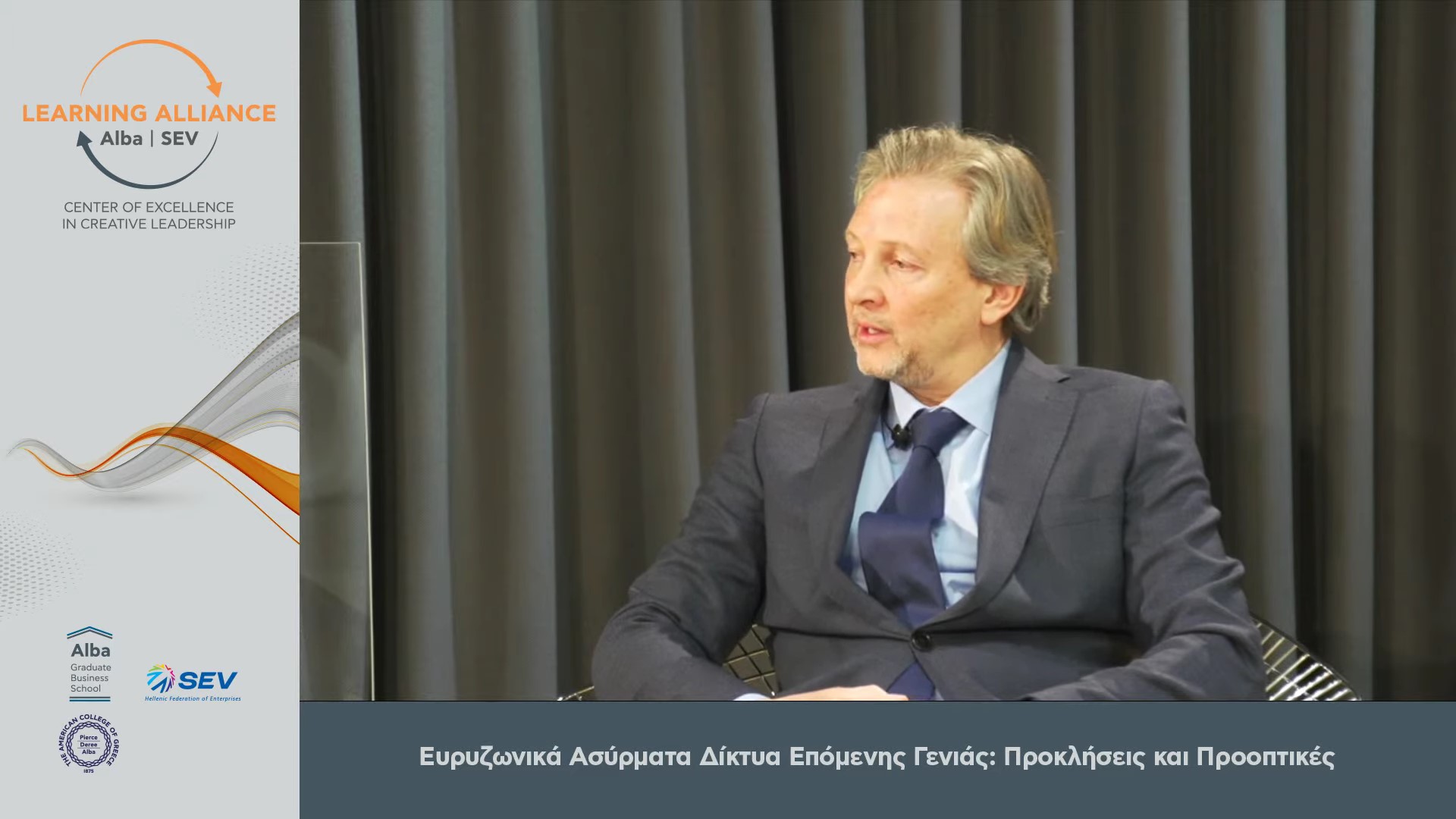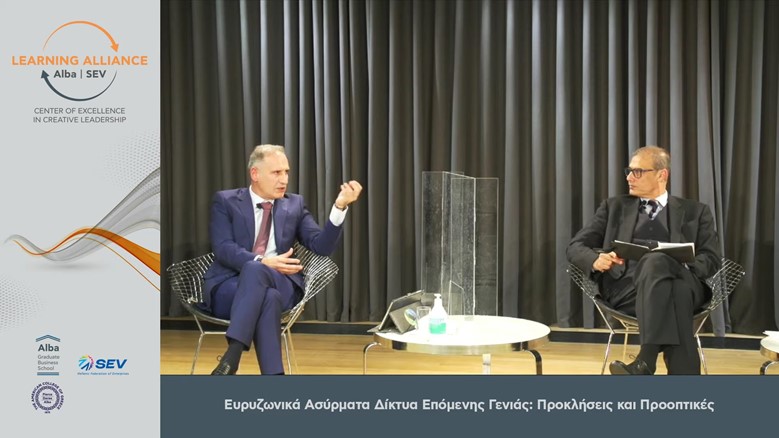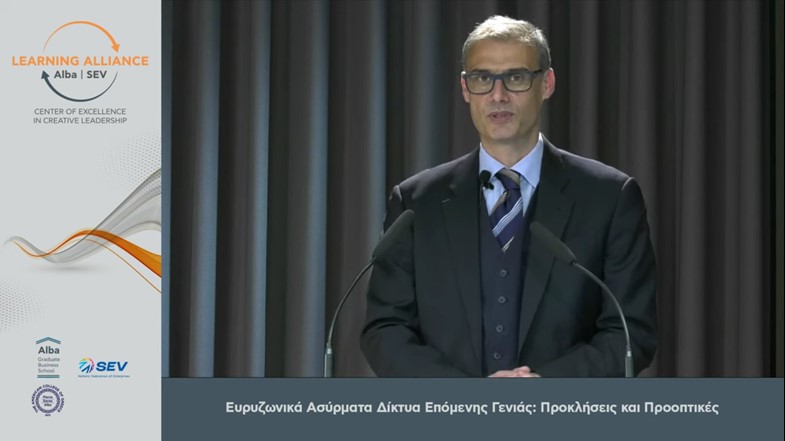Next Generation Broadband Wireless Networks: Challenges & Opportunities
An online event in the context of the Lead Creatively: Discussion Series, organized by the SEV Center of Excellence in Creative Leadership

The critical technologies that defined the evolution of 5G wireless networks as well as the policies that are expected to positively influence the industry in the future, were the focus of the online event themed “Next Generation Broadband Wireless Networks: Challenges & Opportunities” organized by the SEV Center of Excellence in Creative Leadership and Alba Graduate Business School in the context of the third year of the Center’s operation.
The presentation was delivered by Dr. Constantinos Papadias, Executive Director of the Research, Technology and Innovation Network (RTIN), Professor of Information Technology at The American College of Greece while the panel discussion that followed featured, together with Dr. Papadias, Mr. Ioannis Konstantinidis, OTE Group Chief Strategy, Transformation & Wholesale Officer, Member of the Digital Economy Committee, SEV, and Dr. Charalampos Mainemelis, Director of the SEV Center of Excellence in Creative Leadership and Professor of Organizational Behavior at Alba Graduate Business School, The American College of Greece.

Based on what Dr. Papadias presented, 5G networks, the installation of which is underway, are expected to benefit from a number of technological solutions under development for several years, like cellular solids, multi-antennas, wireless access via cloud computing, transmission in extremely high frequencies, use of unlicensed spectrum, etc. These solutions aim to satisfy the high demands of the 5G networks and respective applications, especially in relation with transmission speed, transmission in real time and overall user experience.
However, as he mentioned, the full consolidation of 5G networks and their evolution will require a number of new technological solutions and tools, like spectrum sharing for its more effective use, the hybrid antenna arrays for the increase in the quality of wireless transmission and the decrease of interference and the use of portable access points for the most energy efficient wireless transmission. The value of these technologies was showcased via indicative results which came to light as a result of joint research work.
A number of other technologies were also mentioned, which possibly play a decisive role in the evolution of 5G networks and today’s model of use, like the fixed wireless broadband access, that is the potential for broadband access to fixed structures via wireless networks instead of optical fiber.

Discussing the role of a regulatory framework in the development of the above industry, Dr. Papadias mentioned that it is especially crucial, since the regulatory authorities are –among other things– responsible for the spectrum licensing, for the type of license models used, for how this is shared among different providers. In short, they are those that shape the competitive environment, which services co-exist, and how citizens can choose among different types of services so that they can eventually enjoy quality services at low prices.
With respect to the future trends of the regulatory framework, Dr. Papadias noted among others: “There is a trend to extend the environment to more diverse types of users and providers and to new models of spectrum use. Moreover, we are noticing that there is great emphasis on data protection, which to a degree reflects the level of globalization, so that devices can operate in different geographical areas.”
Finally, Dr. Papadias mentioned some future industry directions, namely the energy autonomous networks, the user-centered network structure, the liquid antennas, the machine learning and quantum cryptography, while he briefly presented the lab team of the Smart Wireless Future Technologies (SWIFT) of The American College of Greece and praised the important research work they are carrying out.
In the panel discussion that followed, the participants discussed the organizational challenges and entrepreneurial opportunities that the next generation of broadband wireless networks can offer the leadership of modern enterprises.

Mr. Konstantinidis, member of the Digital Economy Committee, SEV, and OTE Group Chief Strategy, Transformation & Wholesale Officer, commented on the importance of the digital transformation: “Technology and new generation networks, amidst the pandemic, kept our window to the world open and highlighted the absolute priority of the digital transformation. It is therefore crucial that the state and enterprises alike to speed up their pace in this direction in order to ensure their viability in the digital era. At SEV we recognize the need to accelerate the country’s and the economy’s digital transformation and materialize multi-faceted actions in the context of the Digital Economy Committee.”
Speaking of the new generation networks, he commented that they will constitute the foundation of the digital era and that they will help ignite the development of innovative applications and business models that will benefit the enterprises and the economy, contributing at the same time in improving the people’s everyday lives. Lastly, with respect to the 5G, Mr. Konstantinidis mentioned that in order to make the best of its possibilities, the creation of a dynamic ecosystem through the close collaboration of ΙΤ, enterprises and innovation is imperative.

For his part, Dr. Charalampos Mainemelis, Director of the SEV Center of Excellence in Creative Leadership and Professor of Organizational Behavior at Alba Graduate Business School, The American College of Greece commented: “The topic was particularly timely, given that the installation of 5G networks is currently underway. The cutting-edge speech by Dr. Papadias enriched our knowledge about the technological, regulatory and normative dimensions of the new generation of broadband wireless networks. In the stimulating panel discussion that followed, we had the chance to examine together with Dr Papadias and Mr Konstantinidis the broader organizational, strategic, and social implications of this significant technological evolution.”
You may watch the recording of the presentation and the fruitful and engaging panel discussion that followed below.





